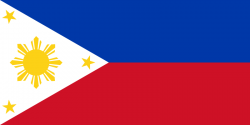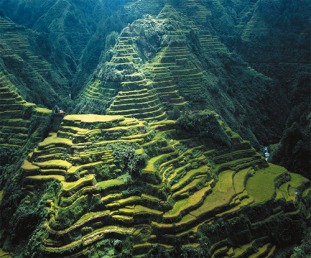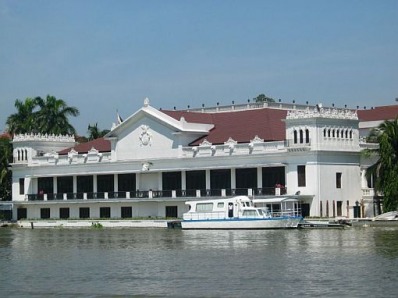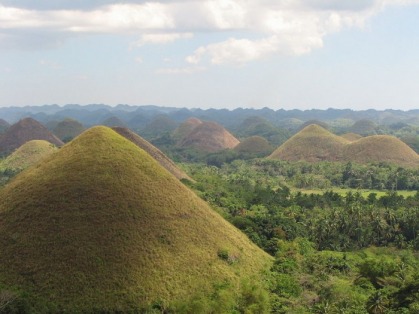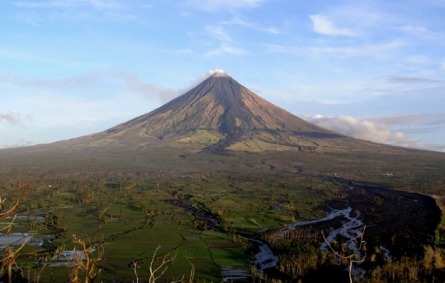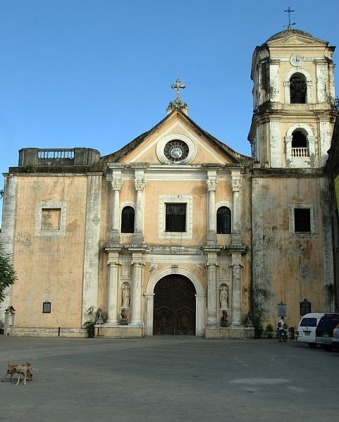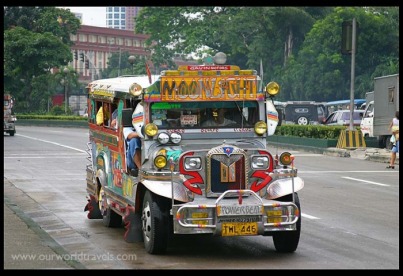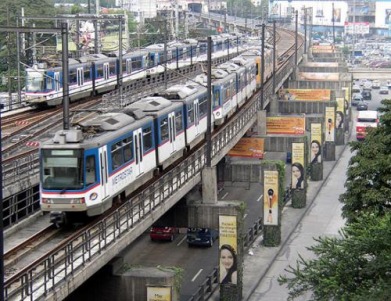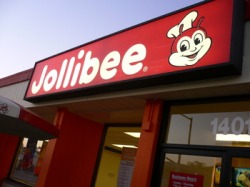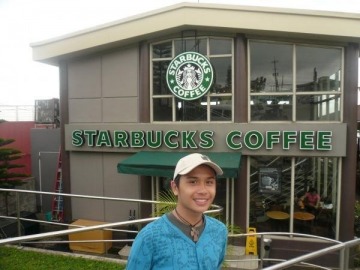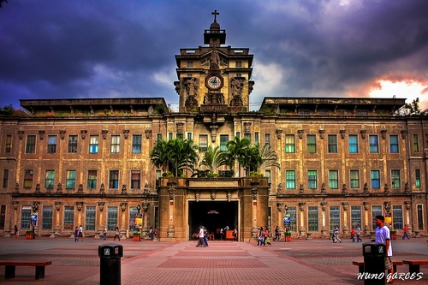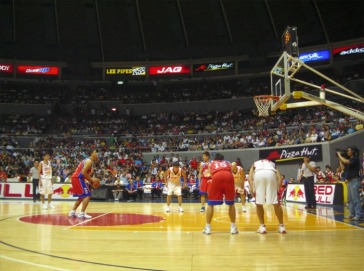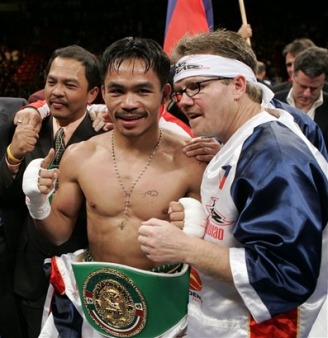The Philippines is a country in Southeast Asia with Manila as its capital city. It comprises 7,107 islands in the western Pacific Ocean.
The Philippines is the world's 12th most populous country, with an estimated population of about 92 million people. Its national economy is the 47th largest in the world, with an estimated 2008 gross domestic product (GDP nominal) of over US$ 168.6 billion (nominal). It is estimated that there are about 11 million overseas Filipinos worldwide, equivalent to about 11% of the total population of the Philippines.
A former colony of Spain and the United States, the Philippines is one of two predominantly Roman Catholic countries in Asia, the other being East Timor. There are also a number of minority religious groups, including Islam, Buddhism, Hinduism, and other beliefs. Multiple ethnicities, and cultures are found throughout the islands. Ecologically, the Philippines is one of the most diverse countries in the world.
The name Philippines was derived from King Philip II of Spain in the 16th century. Spanish explorer Ruy López de Villalobos used the name Las Islas Filipinas, in honor of the Prince of Asturias (Spain) during his expedition to the islands, originally referring to the islands of Leyte, and Samar. Despite the presence of other names, the name Filipinas was chosen as the name of the archipelago.
The name Philippines was derived from King Philip II of Spain in the 16th century. Spanish explorer Ruy López de Villalobos used the name Las Islas Filipinas, in honor of the Prince of Asturias (Spain) during his expedition to the islands, originally referring to the islands of Leyte, and Samar. Despite the presence of other names, the name Filipinas was chosen as the name of the archipelago.
The official name of the Philippines changed throughout the course of its history. During the Philippine Revolution, it was officially called República Filipina or the Philippine Republic. From the period of the Spanish-American War, and the Philippine-American War, until the Commonwealth period, American colonial authorities referred to the country as the Philippine Islands, a translation of the original Spanish name. It was during the American period that the name Philippines began to appear, a name that has become its common name. The official name of the country is now Republic of the Philippines.
Several Baroque churches are included in the list of UNESCO World Heritage Sites, including the San Agustín Church in Manila, the Paoay Church in Ilocos Norte, the Nuestra Señora de la Asunción (Santa María) Church in Ilocos Sur, the Santo Tomás de Villanueva Church in Iloilo, and the Basilica Minore del Santo Niño in Cebu.
COLONIAL ERA HISTORY
n 1521, Portuguese-born Spanish explorer Ferdinand Magellan arrived at Samar and Leyte, and claimed the islands for Spain. Colonization began when Spanish explorer Miguel López de Legazpi, arrived from Mexico in 1565, and formed the first European settlements in Cebu. In 1571, the Spanish conquered the kingdom of Maynila and Tondo and established Manila as the capital of the Spanish East Indies. The colony was governed as a territory of the Viceroyalty of New Spain from 1565 to 1821, and administered directly from Spain from 1821 to 1898.
The fragmented nature of the islands made it easy for Spanish conquest. The Spaniards merely pitted the divided peoples against each other. The Spanish then attempted to bring political unification to the Philippine archipelago via the conquest of various local states but they were unable to subjugate the Sultanates of southern Mindanao nor the highland societies of northern Luzon. Nevertheless, the Spanish introduced elements of western civilization such as the code of law, western printing and the Gregorian calendar alongside new foodstuffs such as maize, pineapple and chocolate from Latin America. From 1565 to 1821, the Philippines was governed from Mexico City via the Royal Audiencia of Manila, before it was administered directly from Madrid after the Mexican revolution. The Manila Galleons which linked Manila to Acapulco traveled once or twice a year between the 16th and 19th centuries. The Spanish military fought off various indigenous revolts and several external colonial challenges, specially from the British, Chinese pirates, Dutch, and Portuguese. Roman Catholic missionaries converted most of the lowland inhabitants to Christianity and founded schools, universities, and hospitals. In 1863 a Spanish decree introduced education, establishing public schooling in Spanish.
After the British occupation of 1762-1764, the Spanish opened Philippine ports to world trade. Wealth increased, and many criollos and mestizos became rich. The influx of Spanish and Mexican settlers secularized churches and government positions traditionally held by the criollos. The ideals of revolution also began to spread through the islands. Criollo insurgency resulted in the Novales mutiny, and the revolt in Cavite El Viejo in 1872 that would lead to the Philippine Revolution.
The first official census in the Philippines was carried out in 1878. As of December 31, 1877, the country's population was recorded at 5,567,685 persons.
The rise of Philippine nationalism grew after colonial authorities executed three progressive secular priests, Mariano Gómez, José Burgos, and Jacinto Zamora (known as Gomburza), who were accused of rebellion, in 1872.This would inspire a Propaganda Movement in Spain, organized by expatriate patriots José Rizal, Marcelo H. del Pilar, and Mariano Ponce, lobbying for political reforms in the Philippines. The movement produced a newspaper, La Solidaridad. Rizal, who wrote the novels Noli Me Tangere, and El Filibusterismo, returned to the Philippines and established the organization La Liga Filipina which also called for reforms. He was exiled to Dapitan, where he met Josephine Bracken. He was executed on December 30, 1896, on charges of rebellion.
Andrés Bonifacio, meanwhile, established the secret society Katipunan in 1892, which sought independence from Spain through armed revolt.Bonifacio and the Katipunan started the Philippine Revolution in 1896. A faction of the Katipunan, the Magdalo of Cavite province, challenged Bonifacio's position as the leader of the revolution. Emilio Aguinaldo took over from Bonifacio (who was executed afterwards) and formed the Republic of Biak-na-Bato in 1897. A ceasefire was agreed at the Treaty of Biak-na-Bato, which led to the revolutionary leaders to depart for Hong Kong, in exile, officially ending the revolution on May 17, 1897, though rebel activities continued regardless of the treaty.
The Spanish-American War began in Cuba in 1898, and reached the Philippines after the United States fought Spain in the Battle of Manila Bay. Aguinaldo, now unofficially allied with the United States, returned from exile and declared Philippine independence from Spain in Kawit, Cavite on June 12, 1898, and established the República Filipina or the Philippine Republic in Malolos, Bulacan the following year. Meanwhile, the islands were unlawfully ceded[citation needed], together with Cuba, Puerto Rico, and Guam, to the United States for $20 million during the Treaty of Paris. This lead to the Philippine-American War, during which, Aguinaldo was captured on March 23, 1901. The war (along with the Moro Rebellion), continued until 1913. At least 34,000 Filipinos lost their lives as a direct result of the war, and as many as 200,000 may have died as a result of the cholera epidemic at the war's end.
As a result of the Jones Law and the subsequent Tydings-McDuffie Act, the Philippines became a Commonwealth. The Commonwealth was officially inaugurated in November 15, 1935. Manuel L. Quezon was elected as president in 1935, with the task of preparing the country for full sovereignty. During his term numerous tasks regarding agrarian reform were initiated, including the colonization of Mindanao, an area considered as part of the hinterlands at the time. He also faced several challenges from leftist groups, such as the Sakdalista. Apart from this, his projects also included the creation of a new capital and the formation of a unifying National Language.
Efforts to prepare the country for full democracy were hampered by the Japanese invasion during World War II. Despite a valiant effort to defend the country in Bataan and Corregidor, the nation was occupied and was turned into a puppet state, ran by Jose P. Laurel. Numerous war crimes were committed during the years of the occupation, such as the plight of comfort women and the Bataan Death March. In exile, Quezon continued representing the Commonwealth in forums such as the Pacific War Council and the United Nations until his death in 1943. The islands were liberated in 1944-1945; beginning in the Battle of Leyte Gulf, where General Douglas MacArthur led the Allied Forces and the United States Military (U.S. Army, U.S. Navy, and U.S. Marine Corps) and escorted Sergio Osmeña, Quezon's successor, back to the country. The liberation ended after the Battle of Manila, killing almost 100,000 people, bringing the death toll for the country to at least a million dead. On July 4, 1946, the United States finalized Philippine independence.
The Philippines is the world's 12th most populous country, with an estimated population of about 92 million people. Its national economy is the 47th largest in the world, with an estimated 2008 gross domestic product (GDP nominal) of over US$ 168.6 billion (nominal). It is estimated that there are about 11 million overseas Filipinos worldwide, equivalent to about 11% of the total population of the Philippines.
A former colony of Spain and the United States, the Philippines is one of two predominantly Roman Catholic countries in Asia, the other being East Timor. There are also a number of minority religious groups, including Islam, Buddhism, Hinduism, and other beliefs. Multiple ethnicities, and cultures are found throughout the islands. Ecologically, the Philippines is one of the most diverse countries in the world.
The name Philippines was derived from King Philip II of Spain in the 16th century. Spanish explorer Ruy López de Villalobos used the name Las Islas Filipinas, in honor of the Prince of Asturias (Spain) during his expedition to the islands, originally referring to the islands of Leyte, and Samar. Despite the presence of other names, the name Filipinas was chosen as the name of the archipelago.
The name Philippines was derived from King Philip II of Spain in the 16th century. Spanish explorer Ruy López de Villalobos used the name Las Islas Filipinas, in honor of the Prince of Asturias (Spain) during his expedition to the islands, originally referring to the islands of Leyte, and Samar. Despite the presence of other names, the name Filipinas was chosen as the name of the archipelago.
The official name of the Philippines changed throughout the course of its history. During the Philippine Revolution, it was officially called República Filipina or the Philippine Republic. From the period of the Spanish-American War, and the Philippine-American War, until the Commonwealth period, American colonial authorities referred to the country as the Philippine Islands, a translation of the original Spanish name. It was during the American period that the name Philippines began to appear, a name that has become its common name. The official name of the country is now Republic of the Philippines.
Several Baroque churches are included in the list of UNESCO World Heritage Sites, including the San Agustín Church in Manila, the Paoay Church in Ilocos Norte, the Nuestra Señora de la Asunción (Santa María) Church in Ilocos Sur, the Santo Tomás de Villanueva Church in Iloilo, and the Basilica Minore del Santo Niño in Cebu.
COLONIAL ERA HISTORY
n 1521, Portuguese-born Spanish explorer Ferdinand Magellan arrived at Samar and Leyte, and claimed the islands for Spain. Colonization began when Spanish explorer Miguel López de Legazpi, arrived from Mexico in 1565, and formed the first European settlements in Cebu. In 1571, the Spanish conquered the kingdom of Maynila and Tondo and established Manila as the capital of the Spanish East Indies. The colony was governed as a territory of the Viceroyalty of New Spain from 1565 to 1821, and administered directly from Spain from 1821 to 1898.
The fragmented nature of the islands made it easy for Spanish conquest. The Spaniards merely pitted the divided peoples against each other. The Spanish then attempted to bring political unification to the Philippine archipelago via the conquest of various local states but they were unable to subjugate the Sultanates of southern Mindanao nor the highland societies of northern Luzon. Nevertheless, the Spanish introduced elements of western civilization such as the code of law, western printing and the Gregorian calendar alongside new foodstuffs such as maize, pineapple and chocolate from Latin America. From 1565 to 1821, the Philippines was governed from Mexico City via the Royal Audiencia of Manila, before it was administered directly from Madrid after the Mexican revolution. The Manila Galleons which linked Manila to Acapulco traveled once or twice a year between the 16th and 19th centuries. The Spanish military fought off various indigenous revolts and several external colonial challenges, specially from the British, Chinese pirates, Dutch, and Portuguese. Roman Catholic missionaries converted most of the lowland inhabitants to Christianity and founded schools, universities, and hospitals. In 1863 a Spanish decree introduced education, establishing public schooling in Spanish.
After the British occupation of 1762-1764, the Spanish opened Philippine ports to world trade. Wealth increased, and many criollos and mestizos became rich. The influx of Spanish and Mexican settlers secularized churches and government positions traditionally held by the criollos. The ideals of revolution also began to spread through the islands. Criollo insurgency resulted in the Novales mutiny, and the revolt in Cavite El Viejo in 1872 that would lead to the Philippine Revolution.
The first official census in the Philippines was carried out in 1878. As of December 31, 1877, the country's population was recorded at 5,567,685 persons.
The rise of Philippine nationalism grew after colonial authorities executed three progressive secular priests, Mariano Gómez, José Burgos, and Jacinto Zamora (known as Gomburza), who were accused of rebellion, in 1872.This would inspire a Propaganda Movement in Spain, organized by expatriate patriots José Rizal, Marcelo H. del Pilar, and Mariano Ponce, lobbying for political reforms in the Philippines. The movement produced a newspaper, La Solidaridad. Rizal, who wrote the novels Noli Me Tangere, and El Filibusterismo, returned to the Philippines and established the organization La Liga Filipina which also called for reforms. He was exiled to Dapitan, where he met Josephine Bracken. He was executed on December 30, 1896, on charges of rebellion.
Andrés Bonifacio, meanwhile, established the secret society Katipunan in 1892, which sought independence from Spain through armed revolt.Bonifacio and the Katipunan started the Philippine Revolution in 1896. A faction of the Katipunan, the Magdalo of Cavite province, challenged Bonifacio's position as the leader of the revolution. Emilio Aguinaldo took over from Bonifacio (who was executed afterwards) and formed the Republic of Biak-na-Bato in 1897. A ceasefire was agreed at the Treaty of Biak-na-Bato, which led to the revolutionary leaders to depart for Hong Kong, in exile, officially ending the revolution on May 17, 1897, though rebel activities continued regardless of the treaty.
The Spanish-American War began in Cuba in 1898, and reached the Philippines after the United States fought Spain in the Battle of Manila Bay. Aguinaldo, now unofficially allied with the United States, returned from exile and declared Philippine independence from Spain in Kawit, Cavite on June 12, 1898, and established the República Filipina or the Philippine Republic in Malolos, Bulacan the following year. Meanwhile, the islands were unlawfully ceded[citation needed], together with Cuba, Puerto Rico, and Guam, to the United States for $20 million during the Treaty of Paris. This lead to the Philippine-American War, during which, Aguinaldo was captured on March 23, 1901. The war (along with the Moro Rebellion), continued until 1913. At least 34,000 Filipinos lost their lives as a direct result of the war, and as many as 200,000 may have died as a result of the cholera epidemic at the war's end.
As a result of the Jones Law and the subsequent Tydings-McDuffie Act, the Philippines became a Commonwealth. The Commonwealth was officially inaugurated in November 15, 1935. Manuel L. Quezon was elected as president in 1935, with the task of preparing the country for full sovereignty. During his term numerous tasks regarding agrarian reform were initiated, including the colonization of Mindanao, an area considered as part of the hinterlands at the time. He also faced several challenges from leftist groups, such as the Sakdalista. Apart from this, his projects also included the creation of a new capital and the formation of a unifying National Language.
Efforts to prepare the country for full democracy were hampered by the Japanese invasion during World War II. Despite a valiant effort to defend the country in Bataan and Corregidor, the nation was occupied and was turned into a puppet state, ran by Jose P. Laurel. Numerous war crimes were committed during the years of the occupation, such as the plight of comfort women and the Bataan Death March. In exile, Quezon continued representing the Commonwealth in forums such as the Pacific War Council and the United Nations until his death in 1943. The islands were liberated in 1944-1945; beginning in the Battle of Leyte Gulf, where General Douglas MacArthur led the Allied Forces and the United States Military (U.S. Army, U.S. Navy, and U.S. Marine Corps) and escorted Sergio Osmeña, Quezon's successor, back to the country. The liberation ended after the Battle of Manila, killing almost 100,000 people, bringing the death toll for the country to at least a million dead. On July 4, 1946, the United States finalized Philippine independence.
POLITICS AND GOVERNMENT
The Philippines has a presidential, unitary form of government (with some modification; there is one autonomous region largely free from the national government), where the President functions as both head of state and head of government and is commander-in-chief of the armed forces. The president is elected by popular vote to a single six-year term, during which time she or he appoints and presides over the cabinet.
The bicameral Congress is composed of a Senate, serving as the upper house, with members elected to a six-year term, and a House of Representatives, serving as the lower house, with members elected to a three-year term. They are elected from both legislative districts, and through sectoral representation.
The judicial power is vested in the Supreme Court, composed of a Chief Justice as its presiding officer, and fourteen associate justices, all appointed by the Philippine President from nominations submitted by the Judicial and Bar Council.
There have been attempts since the Ramos administration to change the government to a federal, unicameral, or parliamentary government.
SECURITY AND DEFENSE
Philippine defense is handled by the Armed Forces of the Philippines, which is modeled after the United States armed forces and is composed of three branches: the Air Force, the Army, and the Navy (including the Marine Corps). Civilian security is handled by Philippine National Police under the Department of Interior and Local Government. In metropolitan areas, groups like the Metro Manila Development Authority are in charge of local issues, such as traffic.
In the Autonomous Region in Muslim Mindanao, the largest separatist organizations, the Moro National Liberation Front and the Moro Islamic Liberation Front, are actively engaging the government, seeking more rights and better autonomy for their people. Militant organizations, such as the New People's Army and the Abu Sayyaf Group, have been roaming the provinces, however their presence has decreased in recent years due to successful security provided by the Philippine government.
The Philippines has been an ally of the United States since World War II. It has supported American policies during the Cold War, and has participated in the Korean and Vietnam wars as a result of the country's involvement with SEATO, a group that includes Australia, France, New Zealand, Pakistan, Thailand, the United Kingdom, and the United States. After the start of the War on Terror, there has been additional support from the United States military. The country is currently working with the United States, through a visiting forces agreement, with the intention of ending the insurgency in the country. The Philippines also has a military agreement with Australia. Other important military allies include Brunei, Indonesia, Japan, Malaysia, Singapore, South Korea, Taiwan, Thailand, the United Kingdom, and Vietnam.
The Philippines has a presidential, unitary form of government (with some modification; there is one autonomous region largely free from the national government), where the President functions as both head of state and head of government and is commander-in-chief of the armed forces. The president is elected by popular vote to a single six-year term, during which time she or he appoints and presides over the cabinet.
The bicameral Congress is composed of a Senate, serving as the upper house, with members elected to a six-year term, and a House of Representatives, serving as the lower house, with members elected to a three-year term. They are elected from both legislative districts, and through sectoral representation.
The judicial power is vested in the Supreme Court, composed of a Chief Justice as its presiding officer, and fourteen associate justices, all appointed by the Philippine President from nominations submitted by the Judicial and Bar Council.
There have been attempts since the Ramos administration to change the government to a federal, unicameral, or parliamentary government.
SECURITY AND DEFENSE
Philippine defense is handled by the Armed Forces of the Philippines, which is modeled after the United States armed forces and is composed of three branches: the Air Force, the Army, and the Navy (including the Marine Corps). Civilian security is handled by Philippine National Police under the Department of Interior and Local Government. In metropolitan areas, groups like the Metro Manila Development Authority are in charge of local issues, such as traffic.
In the Autonomous Region in Muslim Mindanao, the largest separatist organizations, the Moro National Liberation Front and the Moro Islamic Liberation Front, are actively engaging the government, seeking more rights and better autonomy for their people. Militant organizations, such as the New People's Army and the Abu Sayyaf Group, have been roaming the provinces, however their presence has decreased in recent years due to successful security provided by the Philippine government.
The Philippines has been an ally of the United States since World War II. It has supported American policies during the Cold War, and has participated in the Korean and Vietnam wars as a result of the country's involvement with SEATO, a group that includes Australia, France, New Zealand, Pakistan, Thailand, the United Kingdom, and the United States. After the start of the War on Terror, there has been additional support from the United States military. The country is currently working with the United States, through a visiting forces agreement, with the intention of ending the insurgency in the country. The Philippines also has a military agreement with Australia. Other important military allies include Brunei, Indonesia, Japan, Malaysia, Singapore, South Korea, Taiwan, Thailand, the United Kingdom, and Vietnam.
INTERNATIONAL RELATIONS
The Philippines' international relations is focused on its ideals of democracy, peace, and trade with other nations, as well as the well-being of the 11 million Overseas Filipinos living outside the country. It has aligned itself with several nations around the world including its Southeast Asian and Asia-Pacific neighbors, the United States, the Middle East, the Vatican, and other countries.
As a founding and active member of the United Nations, it has been elected several times into the Security Council and is an active participant in the Human Rights Council as well as in peacekeeping missions, particularly in East Timor. Aside from the United Nations, the country is also a founding, and active member of ASEAN (Association of Southeast Asian Nations) with the intention of strengthening relations with its Southeast Asian neighbors, and promoting economic, and cultural growth between member states. It has hosted several summits, and is an active contributor on the direction, and policies of the bloc.
The Philippines has participated in international politics with other countries. It has supported most of the policies with regards to foreign affairs. As a Major non-NATO ally, the country supported the United States during the Cold War and the War on Terror. It has committed itself to promote democratic ideals and values. Japan is also treated as an ally due to the Official Development Assistance given to the people. Relations with Spain, Europe, and Latin America remained positive due to shared history, culture, and traditions. Relations with Middle Eastern countries, where more than two million Overseas Filipinos are employed, have been optimistic. Recent foreign policy has been mostly about economic relations with its Southeast Asian and Asia-Pacific neighbors.
The Philippines is a member of the East Asia Summit (EAS), the Asia-Pacific Economic Cooperation (APEC), the Latin Union, the Group of 24, and the Non-Aligned Movement. It is also seeking to strengthen relations with Islamic countries by campaigning for observer status in the OIC.
The Philippines' international relations is focused on its ideals of democracy, peace, and trade with other nations, as well as the well-being of the 11 million Overseas Filipinos living outside the country. It has aligned itself with several nations around the world including its Southeast Asian and Asia-Pacific neighbors, the United States, the Middle East, the Vatican, and other countries.
As a founding and active member of the United Nations, it has been elected several times into the Security Council and is an active participant in the Human Rights Council as well as in peacekeeping missions, particularly in East Timor. Aside from the United Nations, the country is also a founding, and active member of ASEAN (Association of Southeast Asian Nations) with the intention of strengthening relations with its Southeast Asian neighbors, and promoting economic, and cultural growth between member states. It has hosted several summits, and is an active contributor on the direction, and policies of the bloc.
The Philippines has participated in international politics with other countries. It has supported most of the policies with regards to foreign affairs. As a Major non-NATO ally, the country supported the United States during the Cold War and the War on Terror. It has committed itself to promote democratic ideals and values. Japan is also treated as an ally due to the Official Development Assistance given to the people. Relations with Spain, Europe, and Latin America remained positive due to shared history, culture, and traditions. Relations with Middle Eastern countries, where more than two million Overseas Filipinos are employed, have been optimistic. Recent foreign policy has been mostly about economic relations with its Southeast Asian and Asia-Pacific neighbors.
The Philippines is a member of the East Asia Summit (EAS), the Asia-Pacific Economic Cooperation (APEC), the Latin Union, the Group of 24, and the Non-Aligned Movement. It is also seeking to strengthen relations with Islamic countries by campaigning for observer status in the OIC.
GEOGRAPHY
The Philippines constitutes an archipelago of 7,107 islands[9] with a total land area of approximately 300,000 square kilometers (116,000 square miles). It is located between 116° 40', and 126° 34' E. longitude, and 4° 40', and 21° 10' N. latitude, and borders the Philippine Sea on the east, the South China Sea on the west, and the Celebes Sea on the south. The island of Borneo is located a few hundred kilometers southwest, and Taiwan is located directly to the north. The Moluccas and Sulawesi are located to the south-southwest, and Palau is located to the east of the islands.
The Philippines is divided into three island groups: Luzon (Regions I to V, NCR and CAR), Visayas (VI to VIII), and Mindanao (IX to XIII and ARMM). The port of Manila, on Luzon, is the capital city and the second largest city after Quezon City.
Most of the mountainous islands were covered in tropical rainforest and are volcanic in origin. The highest mountain is Mount Apo, located in Mindanao measuring at 2,954 meters (9,692 ft) above sea level. There are many active volcanos such as the Mayon Volcano, Mount Pinatubo, and Taal Volcano. The islands are also located within the typhoon belt of the Western Pacific, and approximately 19 typhoons strike per year.
Located on the northwestern fringes of the Pacific Ring of Fire, the Philippines have experienced frequent seismic and volcanic activities. Around 20 earthquakes are registered daily, though most are too weak to be felt. The last major earthquake was the 1990 Luzon earthquake.
The longest river is the Cagayan River in northern Luzon. Manila Bay is connected to Laguna de Bay by means of the Pasig River. Subic Bay, the Davao Gulf, and the Moro Gulf are some of the important bays. Transversing the San Juanico Strait is the San Juanico Bridge that connects the islands of Samar, and Leyte.
NATURAL RESOURCES
The Philippines has abundant natural resources in areas such as agriculture, natural beauty, and minerals. It has fertile lands, diverse flora and fauna, extensive coastlines, and rich mineral deposits.
Endemic species include the tamaraw of Mindoro, and the tarsier of Bohol. The Philippines lacks predators, with the exception of snakes, such as pythons, cobras, and birds of prey, such as the national bird, known as the Philippine eagle. Other native animals include the palm civet cat, the Mouse deer, the Visayan warty pig, and several species of bats.
Rainforests boast an array of flora, including several types of orchids, and rafflesia. The narra is considered as the most important type of hardwood while banyan trees or the balete. The islands' major crops include rice, corn, sugarcane, coconut, abaca, and tobacco. Rice is the most important source of food along with corn. The coconut, mango, watermelon, and other native fruits are important contributors to the nation's income.
Due to the volcanic nature of the islands, mineral deposits are abundant. This also allows the Philippines to become a powerhouse with regards to geothermal energy.
The Philippine territorial waters encompass as much as 1.67 million square kilometers, producing a unique and diverse marine life, an important part of the Coral Triangle. There are 2,400 fish species. Other marine products include corals, pearls, crabs, and seaweeds. The rain forests offer prime habitat for more than 530 species of birds, some 800 species of orchids, and some 8,500 species of flowering plants.
CLIMATE
The Philippines has a tropical climate and is usually hot and humid. The average yearly temperature is around 26.5°C (79.7°F). There are three recognized seasons: "Tag-init" or "Tag-araw" (the hot season or summer from March to May), "Tag-ulan" (the rainy season from June to November), and "Tag-lamig" (the cold season from December to February). The southwest monsoon (from May to October) is known as the "Habagat", and the dry winds of the northeast monsoon (from November to April) as the "Amihan". The coolest month is January, and the warmest is May. Both temperature and humidity levels reach the maximum in April and May. Manila and most of the lowland areas are hot and dusty from March to May. Even at this period, the temperatures rarely rise above 37°C., and sea-level temperatures rarely fall below 27°C. Annual rainfall measures as much as 5,000 millimeters in the mountainous east coast section but less than 1,000 millimeters in some of the sheltered valleys. Sitting astride the typhoon belt, most of the islands experience annual torrential rains and thunderstorms from July to October.
The Philippines constitutes an archipelago of 7,107 islands[9] with a total land area of approximately 300,000 square kilometers (116,000 square miles). It is located between 116° 40', and 126° 34' E. longitude, and 4° 40', and 21° 10' N. latitude, and borders the Philippine Sea on the east, the South China Sea on the west, and the Celebes Sea on the south. The island of Borneo is located a few hundred kilometers southwest, and Taiwan is located directly to the north. The Moluccas and Sulawesi are located to the south-southwest, and Palau is located to the east of the islands.
The Philippines is divided into three island groups: Luzon (Regions I to V, NCR and CAR), Visayas (VI to VIII), and Mindanao (IX to XIII and ARMM). The port of Manila, on Luzon, is the capital city and the second largest city after Quezon City.
Most of the mountainous islands were covered in tropical rainforest and are volcanic in origin. The highest mountain is Mount Apo, located in Mindanao measuring at 2,954 meters (9,692 ft) above sea level. There are many active volcanos such as the Mayon Volcano, Mount Pinatubo, and Taal Volcano. The islands are also located within the typhoon belt of the Western Pacific, and approximately 19 typhoons strike per year.
Located on the northwestern fringes of the Pacific Ring of Fire, the Philippines have experienced frequent seismic and volcanic activities. Around 20 earthquakes are registered daily, though most are too weak to be felt. The last major earthquake was the 1990 Luzon earthquake.
The longest river is the Cagayan River in northern Luzon. Manila Bay is connected to Laguna de Bay by means of the Pasig River. Subic Bay, the Davao Gulf, and the Moro Gulf are some of the important bays. Transversing the San Juanico Strait is the San Juanico Bridge that connects the islands of Samar, and Leyte.
NATURAL RESOURCES
The Philippines has abundant natural resources in areas such as agriculture, natural beauty, and minerals. It has fertile lands, diverse flora and fauna, extensive coastlines, and rich mineral deposits.
Endemic species include the tamaraw of Mindoro, and the tarsier of Bohol. The Philippines lacks predators, with the exception of snakes, such as pythons, cobras, and birds of prey, such as the national bird, known as the Philippine eagle. Other native animals include the palm civet cat, the Mouse deer, the Visayan warty pig, and several species of bats.
Rainforests boast an array of flora, including several types of orchids, and rafflesia. The narra is considered as the most important type of hardwood while banyan trees or the balete. The islands' major crops include rice, corn, sugarcane, coconut, abaca, and tobacco. Rice is the most important source of food along with corn. The coconut, mango, watermelon, and other native fruits are important contributors to the nation's income.
Due to the volcanic nature of the islands, mineral deposits are abundant. This also allows the Philippines to become a powerhouse with regards to geothermal energy.
The Philippine territorial waters encompass as much as 1.67 million square kilometers, producing a unique and diverse marine life, an important part of the Coral Triangle. There are 2,400 fish species. Other marine products include corals, pearls, crabs, and seaweeds. The rain forests offer prime habitat for more than 530 species of birds, some 800 species of orchids, and some 8,500 species of flowering plants.
CLIMATE
The Philippines has a tropical climate and is usually hot and humid. The average yearly temperature is around 26.5°C (79.7°F). There are three recognized seasons: "Tag-init" or "Tag-araw" (the hot season or summer from March to May), "Tag-ulan" (the rainy season from June to November), and "Tag-lamig" (the cold season from December to February). The southwest monsoon (from May to October) is known as the "Habagat", and the dry winds of the northeast monsoon (from November to April) as the "Amihan". The coolest month is January, and the warmest is May. Both temperature and humidity levels reach the maximum in April and May. Manila and most of the lowland areas are hot and dusty from March to May. Even at this period, the temperatures rarely rise above 37°C., and sea-level temperatures rarely fall below 27°C. Annual rainfall measures as much as 5,000 millimeters in the mountainous east coast section but less than 1,000 millimeters in some of the sheltered valleys. Sitting astride the typhoon belt, most of the islands experience annual torrential rains and thunderstorms from July to October.
DEMOGRAPHICS
As of 2009, the Philippines is the world's 12th most populous nation, with a population of over 92 million. In 2009, 11% of Filipinos are living abroad as migrant laborers. An estimated figure of half of the population resides on the island of Luzon. Manila, the capital city, is the eleventh most populous metropolitan area in the world. Life expectancy is 71.09 years, with 74.15 years for females, and 68.17 years for males. Population growth rate between 1995 to 2000 was 3.21% but has decreased to an estimated 1.95% for the 2005 to 2010 period.
ETHNICITY
Filipinos belong to several Asian ethnic groups, grouped within the Malay or Malayo-Polynesian speaking people, who speak Austronesian languages. They originated from a population of Taiwanese aborigines, that migrated to the Philippines thousands of years ago from Taiwan, and brought with them knowledge of agriculture, and ocean-sailing technology. Various people of different races, and nationalities have intermarried with various indigenous ethnic groups. Their descendants are known as mestizos. The official population of all types of mixed blood individuals living in the country remain unknown.
Among the various indigenous ethnic groups are the Visayan, Tagalog, Ilocano, Moro, Kapampangan, Bicolano, Pangasinense, Igorot, Lumad, Mangyan, Ibanag, Badjao, Ivatan, and the Palawan tribes. Negrito, Aeta, and the Ati, are considered the indigenous inhabitants of the islands, and are estimated to number around 300,000 people (0.3%). Other ethnic groups include Chinese, Spanish, American, Arab, British, Europeans, Indonesian, Japanese, Korean, South Asian, and other ethnic groups.
LANGUAGE
Over 180 native languages, and dialects are spoken in the Philippines. They are part of the Borneo-Philippines group of the Malayo-Polynesian languages, which is itself a branch of the Austronesian language family.
According to the 1987 Philippine Constitution, Filipino, and English are the official languages. Filipino is the de facto version of Tagalog, spoken mainly in Metro Manila, and other urban regions. Both Tagalog, and English are used in government, education, print, broadcast media, and business. Major languages recognized in the constitution include Bicolano, Cebuano, Ilocano, Hiligaynon or Ilonggo, Kapampangan, Pangasinan, Tagalog, and Waray-Waray. Spanish, and Arabic are both recognized as auxiliary languages.
Other languages such as Aklanon, Boholano, Chavacano, Zamboangueño, Cuyonon, Ifugao, Itbayat, Ivatan, Kalinga, Kamayo, Kankana-ey, Kinaray-a, Maguindanao, Maranao, Masbatenyo, Romblomanon, Surigaonon, Tausug, Yakan, and several Visayan languages are dominant in their respective provinces.
As of 2009, the Philippines is the world's 12th most populous nation, with a population of over 92 million. In 2009, 11% of Filipinos are living abroad as migrant laborers. An estimated figure of half of the population resides on the island of Luzon. Manila, the capital city, is the eleventh most populous metropolitan area in the world. Life expectancy is 71.09 years, with 74.15 years for females, and 68.17 years for males. Population growth rate between 1995 to 2000 was 3.21% but has decreased to an estimated 1.95% for the 2005 to 2010 period.
ETHNICITY
Filipinos belong to several Asian ethnic groups, grouped within the Malay or Malayo-Polynesian speaking people, who speak Austronesian languages. They originated from a population of Taiwanese aborigines, that migrated to the Philippines thousands of years ago from Taiwan, and brought with them knowledge of agriculture, and ocean-sailing technology. Various people of different races, and nationalities have intermarried with various indigenous ethnic groups. Their descendants are known as mestizos. The official population of all types of mixed blood individuals living in the country remain unknown.
Among the various indigenous ethnic groups are the Visayan, Tagalog, Ilocano, Moro, Kapampangan, Bicolano, Pangasinense, Igorot, Lumad, Mangyan, Ibanag, Badjao, Ivatan, and the Palawan tribes. Negrito, Aeta, and the Ati, are considered the indigenous inhabitants of the islands, and are estimated to number around 300,000 people (0.3%). Other ethnic groups include Chinese, Spanish, American, Arab, British, Europeans, Indonesian, Japanese, Korean, South Asian, and other ethnic groups.
LANGUAGE
Over 180 native languages, and dialects are spoken in the Philippines. They are part of the Borneo-Philippines group of the Malayo-Polynesian languages, which is itself a branch of the Austronesian language family.
According to the 1987 Philippine Constitution, Filipino, and English are the official languages. Filipino is the de facto version of Tagalog, spoken mainly in Metro Manila, and other urban regions. Both Tagalog, and English are used in government, education, print, broadcast media, and business. Major languages recognized in the constitution include Bicolano, Cebuano, Ilocano, Hiligaynon or Ilonggo, Kapampangan, Pangasinan, Tagalog, and Waray-Waray. Spanish, and Arabic are both recognized as auxiliary languages.
Other languages such as Aklanon, Boholano, Chavacano, Zamboangueño, Cuyonon, Ifugao, Itbayat, Ivatan, Kalinga, Kamayo, Kankana-ey, Kinaray-a, Maguindanao, Maranao, Masbatenyo, Romblomanon, Surigaonon, Tausug, Yakan, and several Visayan languages are dominant in their respective provinces.
RELIGION
The Philippines is one of two predominant Roman Catholic countries in Asia, the other being East Timor. It is composed of several diocese, and archdiocese. More than 90% of the population are Christians. About 80% belong to the Roman Catholic Church while the remaining 10% belong to other Christian denominations, such as the Philippine Independent Church, Iglesia ni Cristo, The Church of Jesus Christ of Latter-day Saints, Seventh Day Adventist, United Church of Christ, and the Orthodox Church.
Several Baroque churches are included in the list of UNESCO World Heritage Sites, including the San Agustín Church in Manila, the Paoay Church in Ilocos Norte, the Nuestra Señora de la Asunción (Santa María) Church in Ilocos Sur, the Santo Tomás de Villanueva Church in Iloilo, and the Basilica Minore del Santo Niño in Cebu.
Between 5-10% of the population are Muslim, most of whom live in parts of Mindanao, Palawan, and the Sulu Archipelago, an area known as Bangsamoro or the Moro region.Some have migrated into urban, and rural areas in different parts of the country, particularly in Quiapo, Manila. Most Muslim Filipinos practice Shafi'i, a form of Sunni Islam, while other tribal groups such as the Bajau, practice a form mixed with Animism.
Philippine traditional religions are still practiced by many aboriginal and tribal groups, often syncretized with Christianity and Islam. Animism, Folk religion and Shamanism remain present as undercurrents of mainstream religion, through the albularyo, the babaylan, and the manghihilot. Meanwhile, Buddhism, Taoism, and Chinese folk religion, are dominant in Chinese communities.
Religions such as Bahá'í Faith, Hinduism, Judaism, other spiritual beliefs, and those with no religion form the remaining 5% of the population.
The Philippines is one of two predominant Roman Catholic countries in Asia, the other being East Timor. It is composed of several diocese, and archdiocese. More than 90% of the population are Christians. About 80% belong to the Roman Catholic Church while the remaining 10% belong to other Christian denominations, such as the Philippine Independent Church, Iglesia ni Cristo, The Church of Jesus Christ of Latter-day Saints, Seventh Day Adventist, United Church of Christ, and the Orthodox Church.
Several Baroque churches are included in the list of UNESCO World Heritage Sites, including the San Agustín Church in Manila, the Paoay Church in Ilocos Norte, the Nuestra Señora de la Asunción (Santa María) Church in Ilocos Sur, the Santo Tomás de Villanueva Church in Iloilo, and the Basilica Minore del Santo Niño in Cebu.
Between 5-10% of the population are Muslim, most of whom live in parts of Mindanao, Palawan, and the Sulu Archipelago, an area known as Bangsamoro or the Moro region.Some have migrated into urban, and rural areas in different parts of the country, particularly in Quiapo, Manila. Most Muslim Filipinos practice Shafi'i, a form of Sunni Islam, while other tribal groups such as the Bajau, practice a form mixed with Animism.
Philippine traditional religions are still practiced by many aboriginal and tribal groups, often syncretized with Christianity and Islam. Animism, Folk religion and Shamanism remain present as undercurrents of mainstream religion, through the albularyo, the babaylan, and the manghihilot. Meanwhile, Buddhism, Taoism, and Chinese folk religion, are dominant in Chinese communities.
Religions such as Bahá'í Faith, Hinduism, Judaism, other spiritual beliefs, and those with no religion form the remaining 5% of the population.
TRANSPORTATION
In spite of the mountainous terrain, approximately 14 percent of the 158,810 kilometers (98,110 miles) of roads in the Philippines are paved. Buses, jeepneys, taxis, tricycles and motorcycles are available when getting around the major cities, and towns. In 2007, there are about 5.53 million registered motor vehicles, and an average annual registration rate of 4.55%.
Train service is provided by the Strong Republic Transit System, which unified the three main railway networks that provide service of different areas of Metro Manila, and parts of Luzon, that includes the Manila Light Rail Transit System (LRT), the Manila Metro Rail Transit System (MRT), and the Philippine National Railways (PNR). The Philippine Airlines is the first commercial airline in Asia.
Seaports can be found throughout the islands. The busiest seaports are Manila, Cebu, Iloilo, Davao, Cagayan de Oro, and Zamboanga, which are parts of the 3,219 kilometer of waterways, and seaports. Passenger ships, and other sea vessels such as Superferry, Negros Navigation, and Sulpicio Lines serves Manila, with links to various cities, and towns. In 2003, the 919-kilometer Strong Republic Nautical Highway (SRNH) was established, and this is an integrated set of highway segments, and ferry routes covering 17 cities.
Rivers, such as the Pasig River, and Marikina River, have air-conditioned commuter ferries run by the Pasig River Ferry Service, connecting their numerous tributaries in Manila, Makati City, Mandaluyong City, Pasig City, and Marikina City.
There are 262 airports in the country, 75 of which have runways. The Ninoy Aquino International Airport (NAIA) is the main airport. Other important airports include the Diosdado Macapagal International Airport, Mactan-Cebu International Airport, and Francisco Bangoy International Airport. Philippine Airlines, Asia's oldest commercial airline still operating under its original name, and Cebu Pacific, the leading domestic airline, are the major airlines serving most domestic, and international destinations.
In spite of the mountainous terrain, approximately 14 percent of the 158,810 kilometers (98,110 miles) of roads in the Philippines are paved. Buses, jeepneys, taxis, tricycles and motorcycles are available when getting around the major cities, and towns. In 2007, there are about 5.53 million registered motor vehicles, and an average annual registration rate of 4.55%.
Train service is provided by the Strong Republic Transit System, which unified the three main railway networks that provide service of different areas of Metro Manila, and parts of Luzon, that includes the Manila Light Rail Transit System (LRT), the Manila Metro Rail Transit System (MRT), and the Philippine National Railways (PNR). The Philippine Airlines is the first commercial airline in Asia.
Seaports can be found throughout the islands. The busiest seaports are Manila, Cebu, Iloilo, Davao, Cagayan de Oro, and Zamboanga, which are parts of the 3,219 kilometer of waterways, and seaports. Passenger ships, and other sea vessels such as Superferry, Negros Navigation, and Sulpicio Lines serves Manila, with links to various cities, and towns. In 2003, the 919-kilometer Strong Republic Nautical Highway (SRNH) was established, and this is an integrated set of highway segments, and ferry routes covering 17 cities.
Rivers, such as the Pasig River, and Marikina River, have air-conditioned commuter ferries run by the Pasig River Ferry Service, connecting their numerous tributaries in Manila, Makati City, Mandaluyong City, Pasig City, and Marikina City.
There are 262 airports in the country, 75 of which have runways. The Ninoy Aquino International Airport (NAIA) is the main airport. Other important airports include the Diosdado Macapagal International Airport, Mactan-Cebu International Airport, and Francisco Bangoy International Airport. Philippine Airlines, Asia's oldest commercial airline still operating under its original name, and Cebu Pacific, the leading domestic airline, are the major airlines serving most domestic, and international destinations.
COMMUNICATIONS
The Philippines has one of the most sophisticated cellular phone industry in the world, and one of the highest concentration of users. The telecommunications company is dominated by the Philippine Long Distance Telephone Company, which is also the largest company in the country. Globe Telecom, Smart Communications, and Sun Cellular on the other hand, are three of its largest cellular service providers.
There is an estimated 41 million cellular phone users, the reason that the Philippines has been named as the "Texting Capital of the World",and the ownership rate is increasing. Text messaging have fostered a culture of quick greetings, and forwarded jokes among the Filipinos. Out of these growing number of avid texters, 5.5 million of them use their cellular phones as virtual wallets, making it a leader among developing nations in providing financial transactions over cellular networks.In 2007, The nation sent an average of 1 billion SMS messages per day.
Radio, television, and internet is used frequently. There are approximately 381 AM, and 628 FM stations, and 250 national, and 1,501 cable TV stations, as well as 14 million Internet users or 16% of the total population, being served by almost 100 Internet providers.
The Philippines has one of the most sophisticated cellular phone industry in the world, and one of the highest concentration of users. The telecommunications company is dominated by the Philippine Long Distance Telephone Company, which is also the largest company in the country. Globe Telecom, Smart Communications, and Sun Cellular on the other hand, are three of its largest cellular service providers.
There is an estimated 41 million cellular phone users, the reason that the Philippines has been named as the "Texting Capital of the World",and the ownership rate is increasing. Text messaging have fostered a culture of quick greetings, and forwarded jokes among the Filipinos. Out of these growing number of avid texters, 5.5 million of them use their cellular phones as virtual wallets, making it a leader among developing nations in providing financial transactions over cellular networks.In 2007, The nation sent an average of 1 billion SMS messages per day.
Radio, television, and internet is used frequently. There are approximately 381 AM, and 628 FM stations, and 250 national, and 1,501 cable TV stations, as well as 14 million Internet users or 16% of the total population, being served by almost 100 Internet providers.
CULTURE AND SOCIETY
Philippine culture is a mixture of Eastern, and Western culture. The Hispanic influences are derived from that of Spain, and Mexico. These influences are most evident in literature, folk music, folk dance, language, food, art, and religion. Spanish settlers introduced Iberian-Mexican customs, traditions, and cuisines. Philippine cuisine is a mixture of Asian, and European dishes.
Philippine tradition exhibits festivities known as Barrio fiestas (district festivals) to commemorate their patron saints. One of the most visible Hispanic legacies is the prevalence of Spanish surnames, and names among Filipinos. This peculiarity, unique among the people of Asia, came as a result of a colonial decree, the Clavería edict, for the systematic distribution of family names, and implementation of the Spanish naming system on the population. A Spanish name, and surname among the majority of Filipinos does not always denote Spanish ancestry.
The majority of street names, towns, and provinces are in Spanish. Spanish architecture made a significant imprint in the Philippines. This can be seen in the country's churches, government buildings, and universities. Many Hispanic houses, and buildings are preserved, like the towns in Vigan, and among others. The kalesas, horse-driven carriages, were a mode of transportation during the Spanish period. They are still being used today.
The use of English language in the Philippines is contemporaneous, and is the United States' visible legacy. There is also an influence of American Pop cultural trends, such as the love of fast-food, film, and music. Many street corners exhibits fast-food outlets. Aside from the American commercial industries such as California Pizza Kitchen, McDonald's, Pizza Hut, Burger King, KFC, Starbucks, TGI Fridays, and Shakey's Pizza, local fast-food chains have emerged, including Goldilocks, Jollibee, Greenwich Pizza (acquired by Jollibee in 1994), and Chowking (acquired by Jollibee in 2000). Modern day Filipinos also listen, and watch contemporary European, and American music, and film. However, Original Pilipino Music (also known as OPM), and local films are also appreciated.
Philippine culture has also received influence from various Indigenous culture, and other Cultures of Asia. This includes the Malayo-Polynesian, Islamic, Chinese, and other cultures.
Philippine culture is a mixture of Eastern, and Western culture. The Hispanic influences are derived from that of Spain, and Mexico. These influences are most evident in literature, folk music, folk dance, language, food, art, and religion. Spanish settlers introduced Iberian-Mexican customs, traditions, and cuisines. Philippine cuisine is a mixture of Asian, and European dishes.
Philippine tradition exhibits festivities known as Barrio fiestas (district festivals) to commemorate their patron saints. One of the most visible Hispanic legacies is the prevalence of Spanish surnames, and names among Filipinos. This peculiarity, unique among the people of Asia, came as a result of a colonial decree, the Clavería edict, for the systematic distribution of family names, and implementation of the Spanish naming system on the population. A Spanish name, and surname among the majority of Filipinos does not always denote Spanish ancestry.
The majority of street names, towns, and provinces are in Spanish. Spanish architecture made a significant imprint in the Philippines. This can be seen in the country's churches, government buildings, and universities. Many Hispanic houses, and buildings are preserved, like the towns in Vigan, and among others. The kalesas, horse-driven carriages, were a mode of transportation during the Spanish period. They are still being used today.
The use of English language in the Philippines is contemporaneous, and is the United States' visible legacy. There is also an influence of American Pop cultural trends, such as the love of fast-food, film, and music. Many street corners exhibits fast-food outlets. Aside from the American commercial industries such as California Pizza Kitchen, McDonald's, Pizza Hut, Burger King, KFC, Starbucks, TGI Fridays, and Shakey's Pizza, local fast-food chains have emerged, including Goldilocks, Jollibee, Greenwich Pizza (acquired by Jollibee in 1994), and Chowking (acquired by Jollibee in 2000). Modern day Filipinos also listen, and watch contemporary European, and American music, and film. However, Original Pilipino Music (also known as OPM), and local films are also appreciated.
Philippine culture has also received influence from various Indigenous culture, and other Cultures of Asia. This includes the Malayo-Polynesian, Islamic, Chinese, and other cultures.
EDUCATION
Education in the Philippines is mostly Westernized, based on the American education system. Philippine DepEd reports a functional literacy rate of 84.1% for 2003. Other agencies are much more optimistic. Literacy is about equal for males, and females. Spending for education composes 2.5% of the GDP. There were 42,152 elementary schools and 8,455 high schools registered with Department of Education for school year as of 2008-2009. Classes start in June, and end in March. The majority of colleges, and universities follow a semester calendar from June to October, and November to March. There are a number of foreign schools with study programs. The general pattern of formal education follows six stages:
* Preschool
* Elementary school
* High school
* Post-secondary education
* Graduate education
* Adult education
The Department of Education (DepEd), covers elementary, secondary, and non-formal education; the Technical Education and Skills Development Authority (TESDA) administers the post-secondary, middle-level education training, and development; while the Commission on Higher Education (CHED) supervises the college as well as graduate academic programs, and degrees as well as regulate standards in higher education.
Education in the Philippines is mostly Westernized, based on the American education system. Philippine DepEd reports a functional literacy rate of 84.1% for 2003. Other agencies are much more optimistic. Literacy is about equal for males, and females. Spending for education composes 2.5% of the GDP. There were 42,152 elementary schools and 8,455 high schools registered with Department of Education for school year as of 2008-2009. Classes start in June, and end in March. The majority of colleges, and universities follow a semester calendar from June to October, and November to March. There are a number of foreign schools with study programs. The general pattern of formal education follows six stages:
* Preschool
* Elementary school
* High school
* Post-secondary education
* Graduate education
* Adult education
The Department of Education (DepEd), covers elementary, secondary, and non-formal education; the Technical Education and Skills Development Authority (TESDA) administers the post-secondary, middle-level education training, and development; while the Commission on Higher Education (CHED) supervises the college as well as graduate academic programs, and degrees as well as regulate standards in higher education.
SPORTS AND RECREATION
Various sports are played in the Philippines including basketball, boxing, volleyball, badminton, billiards, football (soccer), ten-pin bowling, and sipa.
Traditional Filipino sports are popular, among the youth, primarily as children's games, such as luksung baka, patintero, pik00o, and tumbang preso. Sungka, while not as popular as it once was, is still viewed as a significant part of the traditional native Filipino games. Card games are popular during festivities, with some, including Pusoy, and Tong-its, being used as a form of illegal gambling. Majhong is played in some Filipino communities.
Basketball is played at both amateur, and professional level, and is considered to be the most popular sport in the Philippines. In almost every corner of the cities, there is a basketball court as it is the favorite recreational activity by Filipinos.
Basketball, boxing, billiards, soccer, horse racing, chess, and ten-pin bowling are the most watched sports. Philippine sports have produced several sports heroes, such as Francisco Guilledo, Flash Elorde, and Manny Pacquiao in boxing, Paulino Alcántara in football (soccer), Carlos Loyzaga, Robert Jaworski, and Ramon Fernandez in basketball, Efren Reyes in billiards,Eugene Torre in chess, and Rafael Nepomuceno in bowling. Motocross, figure skating, cycling, and mountaineering have become popular.
Various sports are played in the Philippines including basketball, boxing, volleyball, badminton, billiards, football (soccer), ten-pin bowling, and sipa.
Traditional Filipino sports are popular, among the youth, primarily as children's games, such as luksung baka, patintero, pik00o, and tumbang preso. Sungka, while not as popular as it once was, is still viewed as a significant part of the traditional native Filipino games. Card games are popular during festivities, with some, including Pusoy, and Tong-its, being used as a form of illegal gambling. Majhong is played in some Filipino communities.
Basketball is played at both amateur, and professional level, and is considered to be the most popular sport in the Philippines. In almost every corner of the cities, there is a basketball court as it is the favorite recreational activity by Filipinos.
Basketball, boxing, billiards, soccer, horse racing, chess, and ten-pin bowling are the most watched sports. Philippine sports have produced several sports heroes, such as Francisco Guilledo, Flash Elorde, and Manny Pacquiao in boxing, Paulino Alcántara in football (soccer), Carlos Loyzaga, Robert Jaworski, and Ramon Fernandez in basketball, Efren Reyes in billiards,Eugene Torre in chess, and Rafael Nepomuceno in bowling. Motocross, figure skating, cycling, and mountaineering have become popular.
